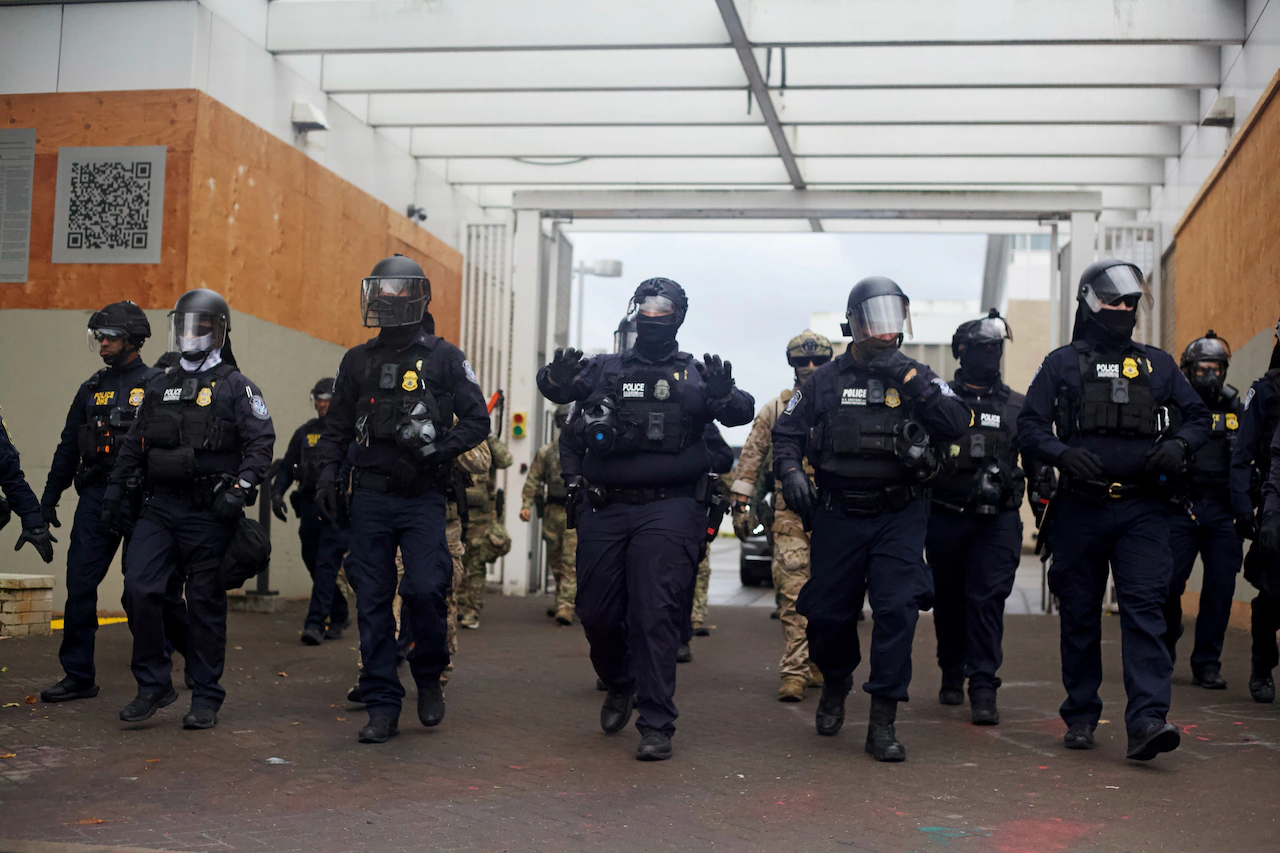Copyright The Oregonian

Supervisors with the Federal Protective Service testified Thursday that Portland police have failed to respond to violence outside the city’s U.S. Immigration and Customs Enforcement office and said they would welcome help from the National Guard to protect the facility. The surge of federal officers to provide around-the-clock protection of the Portland ICE building — dubbed “Operation Skip Jack Portland ” — amid nightly protests is unsustainable, the Federal Protective Service’s deputy regional director testified. He was identified in court only by his initials R.T. for what the federal government said were security purposes. But his name, Robert Cantu, is in multiple court documents, including the federal government’s publicly filed witness list and in sworn declarations. The testimony of Cantu and a colleague came on the second day of trial as the federal government began to present their case in federal court before U.S. District Judge Karin J. Immergut. The judge is weighing whether President Donald Trump was legally justified in calling for the mobilization of Oregon and California national guards to protect the ICE property and federal staff in Portland in late September. Early this month, the judge issued two temporary orders banning the federal deployment of Oregon National Guard and National Guard from any state to Portland. The broader one remains in place through this weekend. Attorneys for the state of Oregon and city of Portland have pointed out, through their cross-examinations, that the number of federal officers at the ICE facility in August and September typically exceeded the number of protesters outside of it and that protests have largely been peaceful. Portland police supervisors, in their testimony, also have sought to contrast what they called inappropriate and disparate force used by federal officers against passive protesters with their more measured approach of using dialogue liaison officers to assess the tenor of a crowd and inserting plainclothes police among demonstrators to identify those who commit crimes, so bike patrol officers can move in and make targeted arrests. Lawyers for the state and city have argued that the unrest caused by federal officers’ excessive force should not be used as justification for Trump’s deployment of Guard soldiers to the city. They’ve argued that the president has failed to legally justify the call-up of National Guard soldiers to protect federal property or officers but instead has “manufactured” a crisis. A Portland police commander testified on the first day of trial that police officers have been instructed not to facilitate federal vehicles coming in and out of the ICE facility due to the state’s sanctuary law. Police also were directed not to provide traffic control in the “immediate area” of the ICE building unless there was an immediate life-safety emergency or to support a tactical operation. Yet, they have attempted to keep Southwest Bancroft Street open for traffic. The Federal Protective Service supervisors said they had no say in Trump’s call-up of Oregon National Guard members and, in fact, were surprised to learn of it from news accounts. But they said the arrival of National Guard soldiers would allow their officers and those from other federal law enforcement agencies to return to their regular jobs. Cantu said he was disappointed by a lack of response and assistance from Portland police, estimating that police did not respond 40 times to requests by Federal Protective Service officers who reached out for help since June at the ICE building. After police declared a riot outside the facility on June 14, federal officers from outside the region as well as officers from U.S. Immigration and Customs Enforcement and U.S. Customs and Border Protection’s tactical team were reassigned to help provide support at the building, he said. Since then, agents from the FBI, the Drug Enforcement Administration, the U.S. Bureau of Alcohol, Tobacco and Explosives and the Bureau of Prisons have also assisted at the ICE facility, Cantu said. “We have people from the Bureau of Prisons who are coming to protect the ICE facility?” U.S. Justice Department lawyer John Bailey asked him, highlighting the unusual assignment. Cantu said yes. During the June 14 riot, two Federal Protective Service officers were injured by thrown fireworks and one ICE officer was struck in the head with an object, presumably a rock, he testified. Protesters had shattered the building’s front door, jamming it with a stop sign and a weight-lifting barbell, he said. “Given the level of violence that was displayed that night, we did expect a response from the Portland Police Bureau,” he said. He said Portland officers eventually did respond, but it wasn’t until just before midnight. “But by that point, there was a level of damage and uncertainty if we ever were going to receive that support from the Portland Police Bureau,” he testified. Cantu also testified that he only witnessed police clear traffic in front of the ICE building on two occasions since June: when the “Emergency” World Naked Bike Ride road past and last weekend. “When PPB is allowed to do their job, do you think they do good police work?” Bailey asked. “Absolutely,” he said. Cantu testified that he believes 180 law enforcement officers are needed to provide 24-hour, seven-day-a week coverage of the ICE building to protect the property and personnel amid the nightly protests. Initially, he said federal officers were sent to the ICE facility for 30-day assignments but that was reduced to 20-day assignments to protect their mental health. They’re typically working overtime, 10 to 12 hours at a time, “constantly in proximity to protesters who say some of the most vulgar, foul, racial slurs consistently through the day, throughout the night” on bullhorns. Cantu also said he believed protesters are coordinating their activities and the federal officers are keeping their ears to a walkie-talkie radio, “hoping to catch cross talk” to try to intercept protesters’ conversations. He said it was something new his agency developed but did not describe the tactic further. During cross-examination, Cantu said there has been a systemic staffing shortage in his agency nationally. There are four Federal Protective Service officers assigned to Portland who are responsible for protecting about 100 federal properties in Oregon and southern Washington state. Across the U.S., there are about 750 Federal Protective Service officers. While he had no say in Trump’s move to authorize National Guard to Portland and only learned about it in news accounts, he said they would relieve the strain on his agency and other federal officers “would be able to go back to doing their primary job.” In a deposition, though, Cantu said he wondered what he would do with 200 Guard members because the ICE building was packed with officers by late September, Senior Assistant Attorney General Brian Marshall pointed out during Cantu’s cross examination. Federal Protective Service officers do not deploy gas but have fired pepper ball launchers and used large canisters of pepper spray. He said FPS officers typically fire pepper balls at the ground, not at people, to get the chemical irritant to come up into the air as a “simple dispersal technique.” But he said the Federal Protective Service also does not track any officers’ deployment of the pepper ball launchers that have been repeatedly used outside the ICE facility. Under cross-examination by Marshall, Cantu said he’s aware there have been three alleged instances of improper uses of force by federal officers within the last two months that are under investigation. The three instances of force were not identified, nor were the agencies involved. Federal Protective Service Cmdr. Will Turner also testified. He was identified in court only by the initials W.T. for what the federal government said were security purposes. Court filings that describe the federal government’s witnesses are not sealed or redacted and identify him as Will Turner. Turner was assigned to the ICE facility every other week for seven days at a time from mid-July through Sept. 20. He cited a hours-long delay in the Portland Police Bureau’s response to a June 14 protest that was later declared a riot outside the ICE building that resulted in the shattering of the building’s front door after demonstrators jammed it with a stop sign and a weight-lifting barbell. Two Federal Protective Service officers were injured by thrown fireworks and an ICE officer was struck in the head with what was believed to be a rock, according to one supervisor. He also complained that Portland police did not remove debris from outside the building, such as sticks or bats, have rarely helped control traffic in front of the ICE building and didn’t work to break up disputes between protesters and counter-protesters on city property. He also said they never sent patrol officers to cordon off the area when the Metro Explosives Disposal Unit was called to investigate a suspicious vehicle that a woman drove to the front of the ICE building and then ran away from on Aug. 18. Despite Portland police providing a designated contact in the bureau for the Federal Protective Service, senior deputy city attorney Naomi Sheffield asked Turner, “you did not typically call the sergeants to request help?” “I did not,” Turner said. Turner testified that federal officers fired pepper balls at protesters who were removing plywood along the east fence of the ICE property, intended to prevent protesters from seeing inside the garage and sally port area of the building. The idea was to block protesters from spotting when federal officers’ cars were leaving to try to “sneak them out” quickly before too many protesters gathered in front of the driveway,” he said. He said protesters have tailed officers home or to their hotels, and have berated them with taunts “to kill ourselves,” called them Nazis and racist slurs. He said he considered the makeshift guillotine assembled outside the ICE facility on Sept. 1 a direct threat, considering some in the crowd had shouted that his officers deserved “to be decapitated.” “Does placing a prop guillotine in the road violate a law?” Sheffield asked. “It does,” Turner testified. “They’re blocking the street, so it’s disorderly conduct.” But he confirmed that simply possessing the prop is not illegal.



